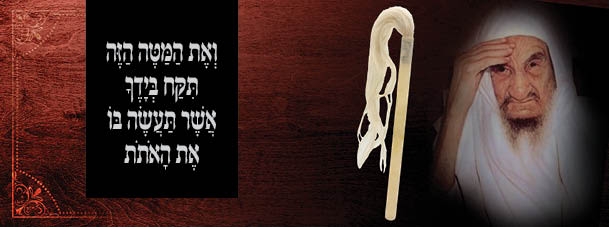
“Rabbi’s Meir’s staff was in my hands and it teaches me knowledge” (Yerushalmi Nedarim 29b)
Especially rare ritual item – the Baba Sali’s wand, which he would hold in his sacred hand while studying over many years in Erfoud, Morocco, and then in the Land of Israel. The head of the wand is made of horsehair for the purpose of shooing away the abundant flying insects common in the hot Moroccan climate.
The great virtues of a tzaddikim’s belongings are well-known for salvation, healing, and all matters. “Everyone” is not ignorant, and it is not for nothing that wealthy people (who are not generally “dupes”) part with large sums from their pockets for tzaddikim’s belongings. Not many know it, but the source of this segulah is already brought in the Talmud Yerushalmi (Nedarim 29b), where, wonder of wonders, this segulah specifically refers to the tzaddik’s wand that would fill those who hold it with wisdom, even many years after the tzaddik’s passing. The Yerushalmi phrases it as follows: “Rabbi’s Meir’s staff was in my hands and it teaches me knowledge.”
Personal wand of the Baba Sali – the greatest Kabbalist of recent generations, which he would hold over the years for most hours of the day, while studying Torah and performing Divine service. Tens of thousands of hours of Kabbalistic study and prayer were absorbed by this inanimate wand, to the extent that there is no comparable item that fits the description in the Yerushalmi so precisely: “Rabbi’s Meir’s staff was in my hands and it teaches me knowledge.” This G-dly staff certainly has the power to impart knowledge to one who holds it and to influence him with an abundance of blessing and success!
This sacred wand was received from the Baba Sali by his legendary assistant Rabbi Eliyahu Alfasi, who was his faithful assistant for 14 whole years, never leaving his side. The Baba Sali famously and affectionately declared about him: “If I could bind you to me with my tefillin straps so that you would not move from my side, I would do it.” Signed authorization included from Rabbanit Sima, R’ Eliyahu Alfasi’s widow, affirming that this wand was used by the Baba Sali over many years and that her husband received it from him as a gift while he was attending him.
Plastic wand with horsehair at the top. wand length: 30 cm, including the hair: Approximately 75 cm.
Very fine condition: Usage stains.
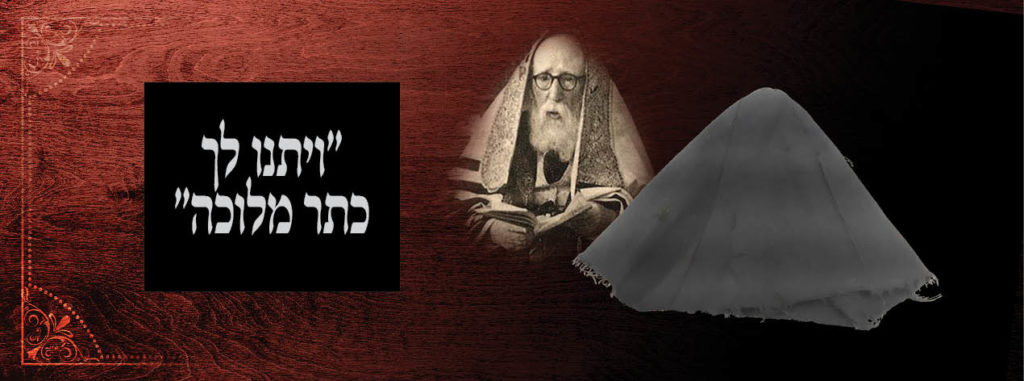
“When an object that was owned by a sacred person is held by someone who is ill, the chitzoni force flees from him, and the patient recovers as a result.” (The Rebbe R’ Moshe of Kossov, author of Lekket Ani )
Kippah lining used by the leading Admo”r of Ruzhin in his generation, the Admo”r, ‘Ba’al Ruach HaKodesh, ‘ Rabbi Yisrael of Husiatyn, paternal grandson of Rabbi Yisrael of Ruzhin. In the dynasty of the royal House of Ruzhin, they would (from inception to this day) keep sacred items from the leaders of the dynasty in special safe rooms, especially the “royal crown” – the Ruzhiner shtreimel – which has never been put up for auction. Presented here is an important ritual item, most regal and significant, offered for the first time at public auction.
As is known, Admo”rs of the House of Ruzhin traditionally wear tall Ruzhiner shtreimels . Following in the dynasty’s regal style, established by Rabbi Yisrael of Ruzhin, who was nicknamed ‘king of the Jewish people, ‘ his descendants continue his resplendent conduct by building magnificent homes and synagogues. The garb worn by Admo”rim of Ruzhin also differs from the other Admo”rim of their time, and they wore a unique shtreimel , with a pointed kippah that rises above the fur; a kind of royal crown.
This ‘shpitz’ kippah is not only the Rebbe’s kippah. As part of the Chassidic shtreimel , it symbolizes the sefirah “Keter” – the highest and most sacred sefirah . The Admo”r Rabbi Naftali of Ropshitz interpreted the letters of the word Shabbat as an abbreviation for ” shtreimel in the place of tefillin”[ שבת: ‘ש’טריימל ב’מקום ת’פילין’]. It is also said in the name of Rabbi Moshe of Ropschitz that a shtreimel is a G-dly contract [שטריימל הוא ‘שטר מאלקים’]. All the more so, the Ruzhiner shpitz symbolizes the royal crown itself.
In addition, this kippah also regularly adorned the Rebbe’s head on Shabbat and festivals, with nothing intervening. Under it, the Rebbe served his Creator with awesome sanctity and purity, his prayers notable for only the movement of his lips without the sound of his voice. At his tisches , divine inspiration would famously emanate from his throat.
This kippah-lining was received from the estate of the renowned Chassid Pinchas Blank, close associate of the Admo”r of Husiatyn and Rabbi Shlomke of Zvhil. (Parenthetically, we will add that Rabbi Pinchas himself was also a lofty individual; it was based on his dream that the Monday-Thursday-Monday segulah at the Admo”r Rabbi Gedaliah Moshe of Zvhil’s grave began; refer to this link Kuntress Ma’ayanot Chaim , page 12.)
Refer to the Hebrew catalog text for a brief biography of Rabbi Yisrael of Husiatyn .
In various Jewish communities around the world, as an auspicious omen, celebrants at significant life-cycle events (ritual circumcision, redemption of the firstborn and weddings) would wear a kippah that was previously used by rabbinic leaders. These kippahs were generally the property of descendants of the tzaddikim or of wealthy individuals who paid a fortune for them, and they would graciously lend them to people hosting family celebrations (until various unscrupulous individuals came along coveting these items for themselves, at which point this lending stopped). The owners of the kippahs would wear them as a segulah on the high holidays – on Rosh HaShanah and on Yom Kippur, or when they were ill.
Pointed kippah made of high-quality especially thick blue fabric. The height of the shpitz is about 14 cm, and its diameter is also approximately 14 cm.
Very fine condition.
* Original letter included from the rosh yeshivah of the Tshebin yeshivah, the gaon Rabbi Baruch Shimon Schneerson, to the seller, Rabbi Yitzchak Blank, in which he refers to him as “The learned avreich , wondrous and expert in Torah and fear of Heaven.”
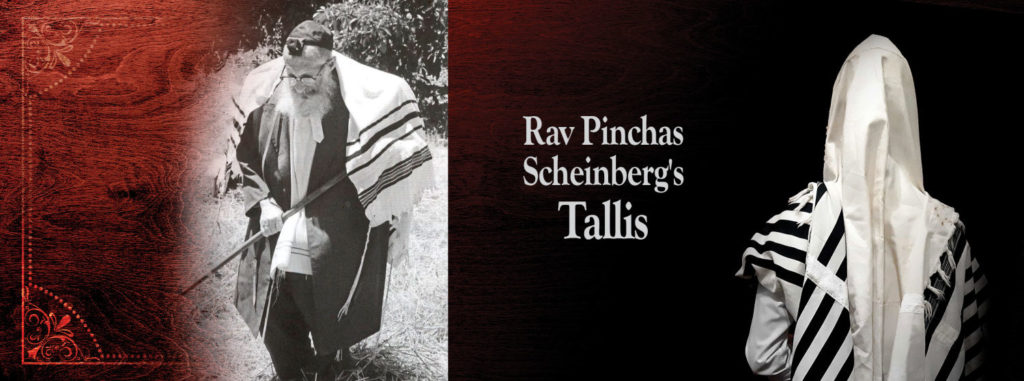
“And the tallit will spread its wings over them and shade them, as an eagle awakens its nest and hovers over its fledglings”
Tallit that belonged to the wondrous gaon and wonder-worker, one of the rabbinic leaders of the previous generation, Rabbi Chaim Pinchas Schenberg, rosh yeshivah of Torah Ore. The rosh yeshivah wrapped himself in this tallit for many years, and every time he served as a sandak during a ritual circumcision, as specified in the enclosed confirmation of authenticity included with this rare and important item. (Per the seller’s request for privacy, we are not publicizing this authorization, but it will obviously be presented and given over to the purchaser).
Rabbi Chaim Pinchas Scheinberg had a special relationship with the mitzvah of tzitzit. One of this wondrous tzaddik’s wondrous ways was that he wore many pairs of tzitzit on top of each other, as well as wearing a tallit on top of his suit jacket! Even as a rosh yeshivah walking in the street, he would wear dozens of pairs of tzitzit, and when he returned home, he added another load of dozens of more tzitziyot, to the point he could hardly be seen through the mountain of tzitziyot. He never revealed the reason for wearing so many pairs of tzitzit, and he denied all the reasons and explanations that others gave for this conduct. However, there was a rumor that he took a vow at a time of distress, either as a type of self-affliction or possibly out of his affection for this mitzvah.
According to signed testimony from the seller (one of his most prominent relatives), the rosh yeshivah would wear this specific tallit not only for his daily prayers, but also whenever he served as sandak at the many ritual circumcisions he would attend, and indeed the edges of the tallit are adorned with many wine stains from the wine goblets used at these ceremonies. It is known that brit wine is an extremely potent segulah for fertility and recovery, and the tallit itself is a segulah for a spouse and for protection from damagers, as stated in Kitvei HeAr”i ( Pri Etz Chaim, Sha’ar HaTzitzit, Chap. 2). Being a sandak is a huge segulah for wealth, as stated in Shulchan Aruch (Ram”a, Yoreh Deah 265:11). When the three greatest segulahs in Judaism unite under the gadol hador’s tallit, there are simply no words!
Refer to the Hebrew catalog text for a brief biography of the gaon Rabbi Chaim Pinchas Scheinberg .
Specifications: Rabbinic tallit with silk stripes at center, somewhat like the silk decorations of most tallitot that go on the wearer’s head. Especially large size (so as to encompass the dozens of pairs of tzitzit that he would wear).
Very fine condition: Adorned with many wine stains from the multiple britot (as specified in the included authorization).
We shall emphasize that Rabbi Scheinberg’s tzitziyot have already appeared at auction several times, but to the best of our knowledge, a tallit of his has never appeared at a public auction!
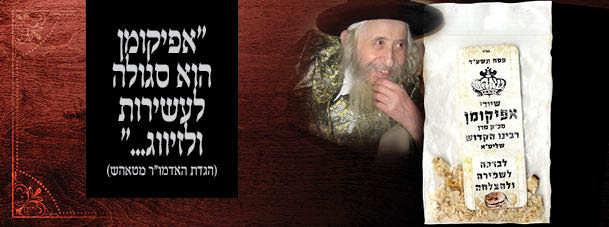
” Afikoman is a segulah for wealth and a spouse, as it says, ‘ MiTzafon zahav yatah ‘ – that is to say, from the afikoman , which is called tzafon (north), wealth will come, and also, ‘ zahav ‘ is an abbreviation for zivug hagun b’karov (finding a proper spouse soon)” ( Haggadat HaAdmo”r MiTosh , owner of this afikoman. )
Leftover pieces [ shirayim ] of the kezeitim of the afikoman eaten by the Admo”r Rabbi Meshulim Feish Segal of Tosh on Seder Night, 2014, the night considered a night of salvation, the loftiest night of the year according to Kabbalah, and the night with the greatest revelations by Chassidic leaders.
One of the most famous – and possibly the most famous – Jewish segulah is that of keeping the afikoman – leaving over a small part of the afikoman and keeping it during the year as a segulah. Sacred literature maintains that this is auspicious for all kinds of salvation; it is certainly considered the ultimate segulah ; a most popular and effective segulah. Below are some of the segulahs associated with keeping a small piece of afikoman during the year – and this is for just any afikoman – and here we are discussing the afikoman that was left over from the kezeitim of the matzah of one of the most unique tzaddikim of recent generations whose hair-raising wonders and miracles were a standard aspect of his Chassidic court, as was well-known. This is, as mentioned, an extremely ancient segulah, crossing generations and sectors, appearing in Kabbalistic writings as well as writings by Chassidic leaders such as: The Kabbalistic work Raphael HaMalach , HaShla”h HaKadosh , Midrash Talpiot , Kaf HaChayim , Imrei Noam , the Admo”r Rabbi Hersheleh of Liska and many others (this is a partial list; refer to the attached photocopies).
Some of the segulahs of saving a piece of the afikoman :
* Segulah for wealth and a spouse, ‘ MiTzafon zahav yatah ‘ ( Avodat HaLevi haggadah, p. 176).
* Segulah for children ‘ U’Tzfoncha temaleh bitnam ‘ ( Imrei Noam Part II page 7).
* Segulah for protection ( HaYashar V’HaTov by Rabbi Tzvi Liska p. 65).
* Segulah for one experiencing difficult childbirth ( Raphael HaMalach section 32)
* Segulah for chasing away damagers ( Eretz Chayim section 425).
* Segulah for being rescued from thieves and from kelipot ( Midrash Talpiot , entry on Afikoman ).
* Segulah for lung illness ( Divrei Geonim p. 85).
* Segulah for protection at sea and on land. (Mahara”m Chagiz in his book Eleh HaMitzvot , Mitzvah 19).
* Segulah to be saved from a fire ( Derech Yesharah by Rabbi Tzvi Hirsch Chust, Furth, 1697)
* Segulah for healing, ” afikoman ” [אפיקמ”ן] has the numerical value of healing [רפ”א] which brings down complete healing for the entire Jewish people. ( Me’or VaShemesh ).
Refer to the Hebrew catalog text for a brief biography of Rabbi Meshulim Feish Segal Lowy .
Specifications: Crumbled piece of matzah placed in a thick plastic bag with a plastic zip-closure with a printed label inside attesting to its contents, Fine condition.
Signed confirmation included supported by documentation from the recipient who sat at the Admo”r’s Seder table and received shirayim of the afikoman matzah from him .
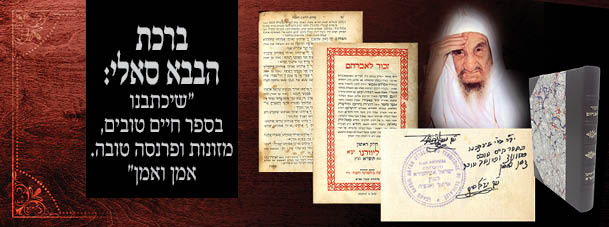
Unparalleled powerful segulah item to definitely be judged favorably – as it says: “A tzaddik decrees and Hashem fulfills”
Machzor that belonged to the leading Kabbalist of recent generations, the Admo”r Rabbi Yisrael Abuchatzeira – “Sidna Baba Sali, ” with which he poured his heart out to G-d with his pure prayers on the great and awesome Day of Judgement, and from which he read the sacred yehi ratzons while eating the simanim on Rosh HaShanah night.
Aside from the powerful segulah concealed in the very act of prayer from this sacred machzor, which does not have to be elaborated upon, it also becomes stronger many times over with the revelation at the end of the machzor – a sacred and awesome matter that has never been seen: A signed promise written by the Baba Sali in the form of the Yehi Ratzons of Rosh HaShanah, in which he asks that Hashem grant the prayers of the person who prays from this machzor, and that he have a good year in all matters! On the last page of the machzor, there is a prayer written, signed and stamped by Sidna Baba Sali, as follows: “May it be Your Will that he be written in the book of good life, sustenance and good livelihood, amen v’amen . Eved Hashem, Yisrael Abuchatzaeira …”
This is a legal and halachic document (and it is known that the Heavenly kingdom works somewhat like the Earthly kingdom) in which the leading tzaddik of recent generations requests that one who prayers from this siddur “will be written in the book of good life, sustenance and good livelihood!” There is certainly no mekatreg who would dare – or even be capable of – blocking the prayers recited from this sacred machzor as they rise heavenward with such a signed and stamped “certificate of passage straight to Heaven”!!
This machzor covers all the Rosh HaShanah prayers from the very beginning, at night, through shofar-blowing – the height of the day – with all the most indescribably powerful Kabbalistic intentions, though the conclusion of this sacred day. Also includes the Tashlich service and the Selichot customarily recited in Elul, as well as those for Tzom Gedaliah.
Traces of the Baba Sali’s tearstains are evident throughout this machzor, as well as leafing-through marks on the leaves’ margins. The usage and traces of tearstains increase and fill the entire page of the Yehi Ratzon hymns designated for after Kiddush on Rosh HaShanah night: “May You renew for us a good and sweet year”; “May the request of those who wish evil upon us be renounced”; “May we be fruitful and multiply like fish and may You watch over us carefully”; “May our evil decree be torn apart” etc. The Talmud Bavli says about these: (Tractate Kritut): “Said Abayyei: It is an auspicious omen [סימנא – מילתא]” – and this is the halachah as stated in the Shulchan Aruch – and all the more forcefully in Kabbalistic works – that the segulah of the Yehi Ratzon s is inestimably valuable as a sign and a segulah for a good year, as we clearly see in this sacred machzor the Baba Sali used as he recited his Divine service. How powerful is the privilege and how great the simana milta of reciting these very Yehi Ratzons from this sacred machzor, accompanied, as mentioned, by the “Certificate of Passage Straight to Heaven.”
Specifications: Machzor Zachor L’Avraham for Rosh HaShanah per the Sephardic custom. Livorno, 1951. [1], 3-316 pp. 19.5 cm.
Fine condition. Many usage marks, as well as sacred tearstains. Restored tears on the title page. New elegant embossed semi-leather binding.
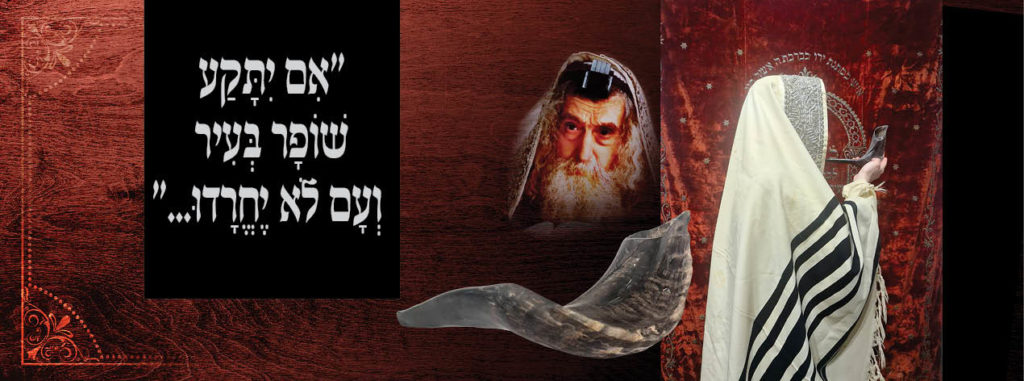
The great shofar shall sound and a still small voice shall be heard
Most sacred! Personal shofar that belonged to the wonder-worker, Rabbi Chaim Zanvl Abramowitz – the Admo”r of Ribnitz, which he himself blew over the course of many years throughout Elul and on Rosh HaShanah, cutting off the mastinim and channelling good, sweet years for his community and the entire Jewish people. Extraordinarily rare and sacred segulah item whose value is difficult to overstate.
As is known, it is the shofar that lifts all the high holiday prayers heavenward and breaks through screens that separate between the Jewish people and their Father in Heaven, as it says in the gemara (Rosh HaShanah 16): “The Holy One, Blessed Be He … said: Recite Malchuyot Zichronot and Shofarot before me on Rosh HaShanah … so that your memories arise before me for the good. How? Through the shofar.” It is not for naught that the shofar blowing is considered the climax of the high holidays. Chronicles of rabbinic leaders are full of stories (and we ourselves have seen) how rabbinic leaders’ eyes would flow with rivers of tears before the shofar blowing, performed with the loftiest possible Kabbalistic intentions. Through the shofar, they cut down the thorns and sweetened the judgment, enacting good sweet years for the Jewish people. This is the shofar sounded over many years by that very special tzaddik of recent generations, the Ribnitzer Rebbe, who served, as known, as the ba’al tokea in his beit midrash – as detailed in the enclosed confirmation – and used on behalf of his congregants and the Jewish people as a whole for many good years. Happy will be he who will be privileged to blow this shofar on the high holidays.
Refer to the Hebrew catalog text for a brief biography of Rabbi Chaim Zanvl Abramowitz .
When the Admo”rs’ belongings were distributed after their passing, the shofar was considered one of the most important items. Usually, the firstborn son – the Admo”r’s successor – would receive it, and in many cases, this heir would have to relinquish his claim to his part in the rest of the items in the inheritance due to the shofar’s great importance. As such, despite the fact that the rest of the Admo”r’s belongings are occasionally sold at auction, an Admo”r’s shofar has apparently never been offered at auction, as they stay in the possession of the Admo”rs’ descendants. This is a one-time opportunity to acquire the shofar of one of the leading Admo”rim of recent generations.
Specifications: Ram’s horn, blackish, bent, medium-sized – approximately 25 cm. Easy-to-blow. Clear sound. Fine condition: The shofar’s kashrut has not been examined.
Signed confirmation by the gabbai Rabbi Ben Tziyon Adler regarding the shofar’s authenticity and that the Rebbe used it over many years.
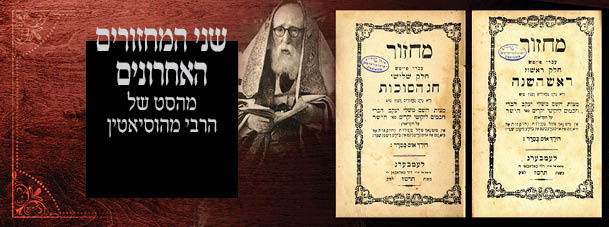
Two Machzorim of the leading Ruzhin Admo”r of his generation, the Admo”r ‘Ba’al Ruach HaKodesh’ Rabbi Yisrael of Husiatyn, the direct grandson, the son of the son (!) of Rabbi Yisrael of Ruzhin. The Machzorim accompanied the Rebbe throughout most of his life, from the time he lived in Husiatyn until his last days in the Land of Israel.
* Machzor for Rosh Hashana, with commentaries. Lemberg, [1907] . An ownership stamp of the sacred Rabbi Yisrael Friedman of Husiatyn appears on the title page: “Library of Yisrael Friedman of Husiatyn”. Of all the Machzorim, the Machzor for Rosh Hashana is the one which is most soaked with tears and prayers for a good year and with it the Admo”r of Husiatyn worked his famous supernatural wonders for one and all.
* Machzor for Sukkot, with commentaries. Lemberg, [1907] . An ownership stamp of the sacred Rabbi Yisrael Friedman of Husiatyn appears on the title page: “Library of Yisrael Friedman of Husiatyn”. The Machzor for Sukkot includes per Chassidut and Kabbalah, the showering of abundance for the year, which is implied in the fruit offerings of the festival in the Mussaf prayers for Sukkot and all the more so on Hoshana Rabba, when the Chassidim traditionally greet each other with ‘A Gutt Kvitel’ and during the Hakafot of Simchat Torah and especially on the Hakafa of ‘Ozer Dalim’, the highlight being the prayer for the rain. All these appear in this sacred Machzor from which the sacred Admo”r of Husiatyn prayed for many years.
As stated, these are the personal Machzorim of the the renowned tzaddik and wonder-worker, the Admo”r Rabbi Yisrael Friedman of Husiatyn, after whom all the leaders of the generation called out, “Mekudash, mekudash.” (In Belz Chassidut, it is accepted that when Rabbi Aharon of Belz would mention the moniker “The Rebbe” without an accompanying name, his intent was the rebbe of Husiatyn, who he referred to as a “tzaddik, pillar of the world” [“צדיק יסוד עולם”]!). With these Machzorim, the Rebbe of Husiatyn would pour out his soul before Hashem with his wondrous prayers. Only his lips would move, no voice would be heard. With these prayers, he would work his famous supernatural wonders for one and all. We will point out that the leaves of the Machzorim are full of the Rebbe’s tear stains along their entire length.
Refer to Hebrew catalog text for a brief biography of the Admo”r Rabbi Yisrael Friedman of Husiatyn.
Machzor for Rosh HaShanah. Lemberg 1907. 151 leaves. 23 cm.
Moderate-fine condition: Many usage marks. Aging and tear stains. Isolated worming perforations. Detached leaves. Dismantled binding, the back binding is different than the front one.
Machzor for Sukkot. Lemberg 1907. 214 leaves. 23 cm.
Fine condition: Many usage marks. Aging and tear stains. Isolated worming perforations. Partially detached binding and leaves. Slight wear to the margins of some leaves.
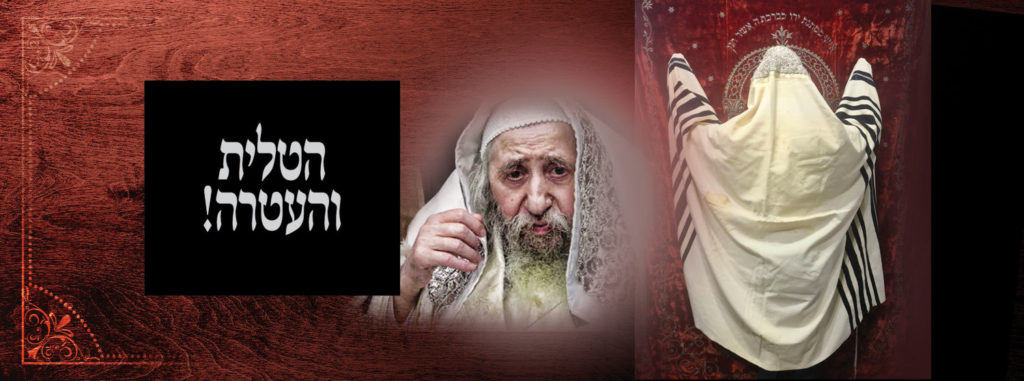
“The tallit spreads its wings over them and saves them, as an eagle awakens its nest and hovers over its fledglings.”
Tallit that belonged to the Admo”r Rabbi Meshulim Feish Segal of Tosh, including an atarah of woven silver threads. The Rebbe wrapped himself in it over a lengthy period, and under it he prayed his famous glory-saturated prayer service that lasted hours upon hours, for the salvation of individuals and the entire community. First-rate ritual object of one of the tzaddikim of previous generations.
This tallit was received as a gift by one of the Admo”rim of our generation, directly from the Rebbe himself! (Refer to the confirmation included with this lot.)
Chassidic leaders revealed the great sanctity concealed within the personal belongings of tzaddikim and their ritual objects, and that they have the power to bring about great salvation. It is told in the name of Rabbi Mordechai of Nezkizh, that he said regarding the vessel given to him by his rabbi, Rabbi Michel of Zlotchov: “This vessel gives the power to perform miracles and wonders …” ( Divrei Binah leaf 47). The source of the importance of the tzaddik’s personal belongings was brought long ago in the name of the Ba’al Shem Tov, by his grandson, the author of Degel Machaneh Ephraim (in parashat Bo): “… All that a person has – his slaves, his servants, his livestock and even all his vessels, are all his sparks, belonging to the root of his soul.” Even the Chata”m Sofer, who is not counted among Chassidim, writes in parashat Toldot: It can be understood from the Yerushalmi that a person’s garments are infused with the wearer’s sanctity, and he who wears them after him will be infused with the same spirit for the better or otherwise; this is the secret of his sons wearing them after him.
There is a well-known segulah to a tallit, aside from its being a Torah commandment which is mentioned three times a day – in kriyat shema . A tallit – and particularly a tallit that belonged to one of the tzaddikim of generations – constitutes a protection against damagers, and is also a segulah for a wife, as it says in the Ar”i’s writings ( Pri Etz Chaim , Sha’ar HaTzitzit, Chapter 2).
Refer to the Hebrew catalog text for a brief biography of Rabbi Meshulim Feish Segal Lowy .
Specifications: Large, wide rabbinical tallit, made of especially thick, high-quality fabric. There is a large, impressive rabbinic atarah at the top of the tallit, made of woven sliver threads. Geflochtene atarah . Signed confirmation of authenticity included from the recipient of this gift, the Admo”r MeHolmen, shlit”a.
Very fine condition: Many usage marks and the Admo”r’s sweat stains. Very slight unravelings in the threads of the atarah .
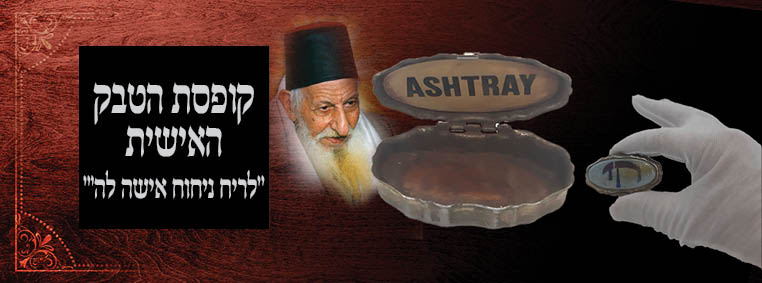
A satisfying aroma, a fire-offering to Hashem
Personal tobacco case that belonged to the leading Kabbalist of the recent generation, Chacham Yitzchak Kadouri, with leftover tobacco from that which was sniffed by Rabbi Kadouri himself. This case and the tobacco in it were inherited by his son, Rabbi David Kadouri, as attested in the enclosed authorization. Extraordinarily rare segulah object.
Personal belongings of tzaddikim are known to have segulah value, all the more so leftover food from tzaddikim that enter the body and become part of the person eating it. Leftover tobacco is at a level beyond this, as it is used for sniffing, and not consumed like food, but directly nourishes the soul, as stated by Chaza”l (Tractate Berachot): “What does the soul enjoy? Smell – as it says, “The entire soul shall praise Hashem.” This is a unique, unparalleled item – a tobacco box including the tobacco – used by the leading Kabbalist of the previous generation, with the ability, according to the tradition detailed below, to enact miracles like its previous owner – the G-dly Kabbalist Chacham Yitzchak Kadouri!
Leading Kabbalists and Admo”rs would secretly be very active while sniffing tobacco. In Kitvei HeAr”i , there is a special chapter dedicated to Kabbalistic intentions while sniffing tobacco. These intentions were derived from the verse “A satisfying aroma, a fire-offering to Hashem. ” It is also said in the name of the Baba Sali that his grandfather, the Abir Ya’akov, had all the Ar”i’s intentions in mind when he sniffed tobacco. Chassidic leaders also used the power of sniffing tobacco. Rebbe Yeshayah of Chechov, son of the Admo”r – the author of Divrei Chaim of Sanz, who inherited his father’s tobacco box, was known to have used it to enact wonders. In recent generations as well, the Admo”r R’ Mosheleh of Lelov’s tobacco box, in his grandchildren’s the Bernstein family’s, possession is a known magnet for the ill of Jerusalem. Anyone who felt unwell would sniff from this box and recover. Even in the most recent generation, the previous Admo”r of Vizhnitz, who had the tobacco box – with a little tobacco – of the dynasty’s progenitor in his possession, would sniff it during high holiday prayers as a segulah for his prayers to be accepted.
Refer to the Hebrew catalog text for a brief biography of Rabbi Yitzchak Kadouri .
Specifications : [1] gilded-metal oval tobacco case. The lid opens with a hinge, and it has a bluish coating with the word “Chai.” Maximum dimensions: Approximately 30×60 mm. There is a considerable amount of tobacco inside the box leftover from that which was inhaled by Rabbi Kadouri. Very fine condition. Slight bend in the lid.
Signed authorization included from the owners of the tobacco case attesting to the case’s chain of transmission until its arrival in his possession.
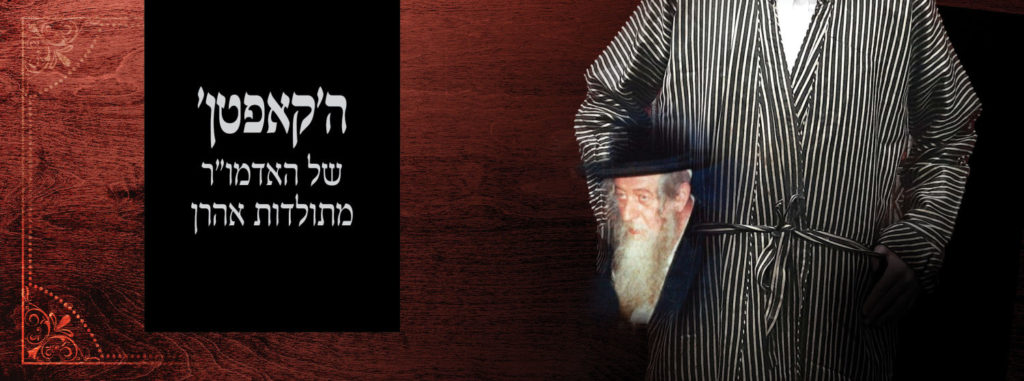
He has dressed me in a cloak of salvation, in a robe of righteousness he has garbed me, like a bridegroom who exalts himself with splendor (Yeshayahu 61:10)
The first Admo”r of Toldot Aharon’s, Rabbi Avraham Yitzchak Kahn’s, silk kaftan. He wore it over many years on a daily basis (as detailed in the attached authorization). Important and sacred ritual item that belonged to one of the tzaddikim of recent generations.
Striped Yerushalmi robe in black and gold, similar to the garb worn by members of the Old Yishuv in Jerusalem, yet more regal and made of high-quality fabric. The kaftan has a matching gartel attached. This kaftan was worn by the rebbe on weekdays (as opposed to the Shabbat kaftan made of fabric in a different color). The Rebbe’s way was to be wrapped in the kaftan the entire day, without a break, except when attending to his needs and going to sleep. He would perform his pure Divine service while wearing this kaftan all throughout the day over many years, during his famous glory-saturated prayers for the salvation of the community and individuals, while lighting Chanukah candles, during ritual circumcisions, at his followers’ weddings and while running his pure tisches .
Not many know it, but the Yerushalmi kaftan is not like the kapotehs worn by Chassidim. Legend has it that it was designed by the Admo”r Rabbi Elazar Mendel of Lelov himself, when he ascended to the Land of Israel in 1851. Rabbi Elazar Mendel would say that our forefathers, when they were in the Land of Israel, would wear the Yerushalmi kaftan. Tailors of this kaftan, primarily those from the Old Yishuv, sew it according to Rabbi Elazar Mendel of Lelov’s tradition, from precisely 26 pieces of fabric, the numerical value of G-d’s name [שם הוי”ה]! It is told that the Mahari”tz Dushinsky, when he ascended from Hungary to Jerusalem, refused to alight from the train until the Yerushalmi kaftan was brought into the train for him. Only after he wrapped himself in it did he deign to descend from the train and enter the gates of Jerusalem.
An especially sacred garment in which one of the sacred personages of recent generations wrapped himself. The Chata”m Sofer famously said on parashat Toldot regarding the garments of tzaddikim: “The Yerushalmi indicates that a person’s clothing draws from its wearer’s sanctity, and one who wears it after him will draw to him that same spirit for the good or otherwise; this is the secret by which sons wear their father’s clothes …”
Refer to the Hebrew catalog text for a brief biography of the Admo”r Rabbi Avraham Yitzchak Kahn .
Yerushalmi kaftan, average size.
Fine condition: Years of wear; no tears.
Confirmation included from the Rebbe’s close associate and disciple, the renowned Chassid Rabbi Aharon Blum (owner of the famous book publisher A. Blum) regarding the authenticity of this garment and that the Rebbe wrapped himself in it over the years.

“Rabbi Chisda said: I wash my hands with an abundance of water and I am granted an abundance of goodness” (Tractate Shabbat 62b)
The renowned tzaddik and wonder-worker Rabbi Yehudaleh Horowitz of Dzikov’s personal netilat yadayim cup that he used to wash his hands for meals on a daily basis, for over twenty consecutive years, in his sacred service with awesome tears not elicited by the desire to eat food, as he would repeat the verse, “You shall sanctify yourselves and you will become holy.” Especially large cup, to fulfill ‘An abundance [lit. handfuls] of water [‘מלא חופניים מים’].’
Rabbinic leaders over the generations were especially fond of this mitzvah of netilat yadayim , identified with abundant sacredness above and beyond that which is required, as this mitzvah was established by Shlomo HaMelech after the Torah was given, and a voice from Heaven announced, ‘With your wise heart, My son, My heart will rejoice as well.” Chassidic leaders especially praised and glorified this mitzvah, and they would adorn it with verses and psalms such as “Hashem is my Shepherd I shall not lack, ” etc. In the original authorization that comes with this item, Rabbi Yehudaleh’s attendant, Rabbi Simchah Hendler, describes Rabbi Yehudahleh’s wondrous netilat yadayim service, which was “a tremendous service” for him, and he would adorn it using the verse, “You shall sanctify yourselves and you will become holy.”
Netilat Yadayim is one of the only segulahs for wealth that appears already in the Babylonian Talmud. Tractate Shabbat states: “Rabbi Chisda said: I wash my hands with an abundance of water and Heaven grants me an abundance of goodness and blessing.” Rabbinic leaders of the generations added that the word “water” [מים] is an abbreviation for “our hands are full from your blessings [“מַ’לֵּא יָ’דֵינוּ מִ’בִּרְכוֹתֶיךָ [וּמֵעֹשֶׁר מַתְּנוֹת יָדֶיךָ]”]. This is a rare and important segulah item that belonged to a unique tzaddik of recent generations – considered by contemporary Admo”rim like a tzaddik of ancient generations – with which he washed his hands tens of thousands of times (!) and imparted the influence of an abundance of blessing and sustenance for the world.
Refer to the Hebrew catalog text for a brief biography of Rabbi Yehudahleh of Dzikov .
Especially large metal cup. Height: 14 cm. Diameter: 14 cm ( gematriah : twice “yad” [“יד”]).
Very fine condition: Many usage marks, very slight dents.
Original confirmation signed by Rabbi Simchah Hendler, Rabbi Yehudahleh’s close associate, affirming that this is the tzaddik’s personal cup for netilat yadayim , and that he used it on a daily basis for many years.
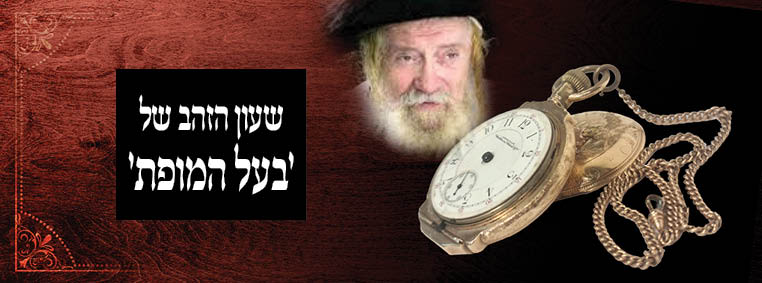
Magnificent gold pocket-watch used over many years by the marvellous tzaddik and wonder-worker, Rabbi Tzvi Hirsch – “Rabbi Hirscheleh” Rosenbaum of Kretchnif (as described in the attached letter from the seller). On the back of the upper cover, there is an engraved dedication: “Gift for the Admo”r shlit”a from Moshe Yuda ben Chavah Tilah Veizer, Haifa.” On the back cover, there is a relief image of an antler-adorned-deer, a reference to the Rebbe’s name. Sacred Chassidic segulah object, rare and one-of-a-kind.
It is told that objects that were owned by a tzaddik continue to carry the sanctity and power of their owner, even posthumously. Refer also to Chiddushei Chatam Sofer on Toldot, where he writes: “A person’s clothing draws from the wearer’s sanctity … and one who wears it after him will draw to him that same spirit for the good or otherwise; this is the secret by which sons wear their father’s clothes.”
Chassidic tradition maintains that a tzaddik’s watch has special significance, and hair-raising tales of wonder are told about watches used by tzaddikim over the generations. They would enact supernatural miracles such as skipping from the present to another point in time. There is also the famous story of the Chozeh of Lublin’s watch which would still affect people many years after his passing, inspiring those who heard its ticking with joy so great they would break out in dance.
This is the personal watch used by one of the most wondrous tzaddikim who lived in the previous generation – the Admo”r “Rabbi Hirsheleh” of Kretchnif, to whom leading Admo”rim would travel to participate in his tisches and request his blessings. This watch was always carried by the Rebbe in his upper vest pocket near his pure heart, continuously over many years, on weekdays, Shabbats and festivals. He would touch it tens and hundreds of times throughout the day, during his glory-saturated prayers that continued into the wee hours of the night; when he conducted his tisches and a voice would come out straight from his throat with spiritual inspiration, as is well-known. This is evident from the many usage marks from the rebbe’s constant contact, when occasionally, in his separation from the material, the Rebbe would bang it on the table.
Refer to the Hebrew catalog text for a brief biography of the Admo”r Rabbi Tzvi Hirsch Rosenbaum .
Specifications: Gold pocket-watch, made by Americana. Stamped: 14kt, with several more quality stamps, as well as the serial number 835687. The watch’s diameter is 5.5 cm. Both sides of the watch have gold covers that open via hinges. At the top of the watch is a crown used to set the time and date, including a ring around the crown attached to a chain for carrying the watch, also made of gold.
Detached front cover and lacking the hour and minute hands. The second hand is working properly. The mechanism is also working properly. The watch is placed in a designated hand-embroidered fabric case.
Signed confirmation of authenticity stating that this watch belonged to the Admo”r and that he used it for years.
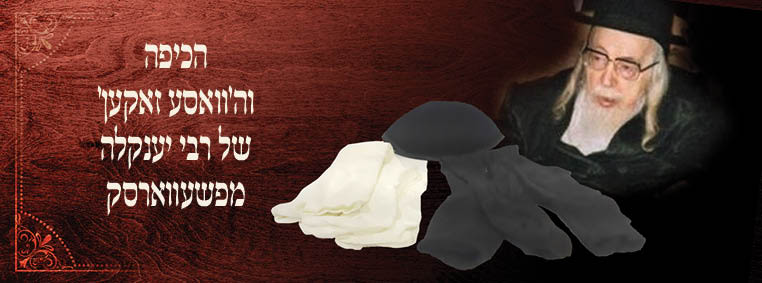
“I will greatly rejoice in G-d for he has clothed me with the garments of salvation, as a bridegroom decks himself with a garland and as a bride adorns herself with her jewels”
A set of clothes [5 pieces!] of the renowned wonder-worker the Admo”r Rabbi Yankeleh of Pshevorsk, one of the leading Admori”m of Europe and one of the most important Admori”m of his generation. Extremely rare pieces of clothing worn by the Rebbe, with nothing intervening.
The pieces include:
* A pair of black socks worn by the Rebbe on the days of the week. On the 21st of Adar (the Hillula of the Rebbe Rabbi Elimelech of Lizhensk) 1997, which that year was on Friday, when the Rebbe changed his clothes for Sabbath, he gave the socks to his devoted meshamesh (as appearing in the enclosed confirmation).
* A pair of white socks – ‘Vaseh Zaken’, which Admori”m wear on Sabbath and Holidays. On Motzaei Chag Shemini Atzeret 1997, the Rebbe gave them to his loyal gabai (as appearing in the enclosed confirmation).
* The velvet Kippah worn by the Rebbe and with which he devotedly and purely worked his Creator. It would be difficult to overstate the value of this sacred and important item! (impressed on the lining of the Kippah is the word “Rabbeinu”).
It is known that all items which belonged to tzaddikim are a tried and true Segulah. As elucidated in the book Divrei Torah by the Minchat Eliezer of Munkatch (Mahadura a, letter 22-23): “We have found that the source of the custom of tzaddikim, our rabbis and forefathers, who ascribed importance to items used by tzaddikim and some tzaddikim and chassidim paid a fortune for such items etc. is in the Yerushalmi that an item used by a tzaddik, even if it is an earthly item, can merit knowledge and all kinds of favors of this world”. All the more so these pieces of clothing, which were worn by the tzaddik with nothing intervening, are capable of healing, as brought in the name of Rabbi Moshe of Kosov author of Leket Ani : “All items that come from the possession of a sacred person, if held by an ill person, the external power flees from him, and the patient is healed along the way”. The superior of these items is the Kippah which is on the tzaddik’s head all day, constituting a carriage for the sacred Shechinah, as written “ועל ראשי שכינת א-ל”.
In various Jewish communities around the world, as an auspicious omen, would wear a kippah that was used by rabbinic leaders at important life occasions (ritual circumcision, redemption of the firstborn and weddings). The kippahs were generally the property of descendants of these tzaddikim or wealthy individual who paid a steep price, and they would graciously lend them to people hosting family celebrations (until various unscrupulous individuals came along desiring to acquire these items for themselves, at which point this lending stopped). The owners of the kippahs themselves would wear them as a segulah on the high holidays – on Rosh HaShanah and on Yom Kippur or when they were ill, as brought in Otzar Yad Hachaim (letter 280): “A pure source among tzaddikim who insist on wearing on Rosh Hashanah and Yom Kippur etc. clothes of past tzaddikim, see Yerushalmi Ta’anit chapter 4 Halachah 1 etc”.
Refer to Hebrew catalog text for a brief biography of Rabbi Yaakov Leiser of Pshevorsk.
Overall condition: Fine.
Enclosed is confirmation signed by the devoted meshamesh of the Rebbe in his last years, Rabbi Shalom Yaakov Yisrael Veyeshurun Kahana, on the authenticity of the items and that they came into his possession in a kosher way, with approval and authority.
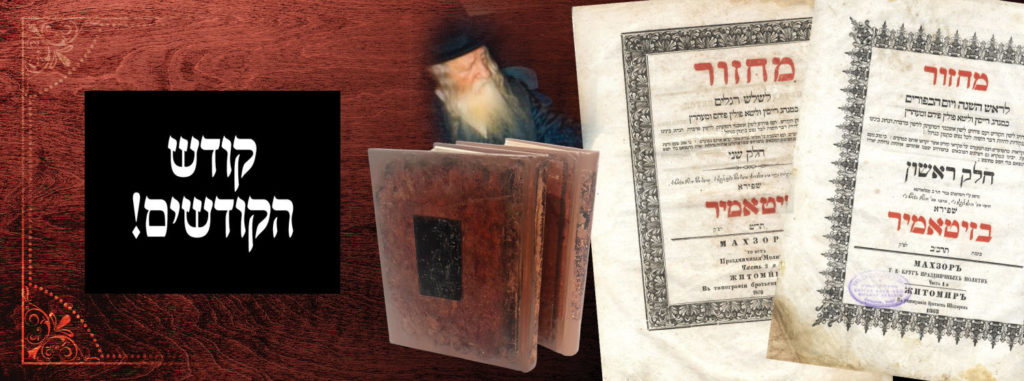
Machzor for the three pilgrimage festivals. Personal copy that belonged to the Admo”r Rabbi Yehudah [Yehudah’leh] Horowitz of Dzikov, that the rebbe used over many years, as attested in the included confirmation from his close confidante, Rabbi Simchah Hendler. Magnificent rabbinic volume with the original leather binding. Extraordinarily important and rare Chassidic ritual item.
As stated, this is the personal machzor of the renowned tzaddik and wonder-worker Rabbi Yehudah’leh of Dzikov, who contemporary rebbes considered a tzaddik of earlier generations. The rebbe poured his soul out with his famous glorious prayers using this machzor during three regalim – with other-worldly joy and sanctity …
Refer to the Hebrew catalog text for a brief biography of Rabbi Yehudah Horowitz .
It is known that leading Admo”rim are particular to pray from sefarim that had been in the use of tzaddikim, or to wear clothing that was used by a tzaddik, as a segulah for their prayers to break through the mekatregim and enact salvation for themselves and for their congregations. It is hard to find a ritual item more suited for the regalim prayers than this Zhitomir machzor, used for Divine service by Rabbi Yehudaleh of Dzikov, considered most sacred by contemporary Chassidic leaders.
Specifications: Machzor printed in sanctity and purity by Rabbis Chanina Lipa and Yehoshua Heschel Shapira, Zhitomir, 1859. 152 leaves. 29.5 cm.
Fine-very fine condition: Aging stains. Minimal worming perforations. Professionally restored original leather binding.
Confirmation included from the Rebbe’s close confidante, Rabbi Simchah Hendler, regarding the authenticity of this machzor and that the tzaddik used it over many years.
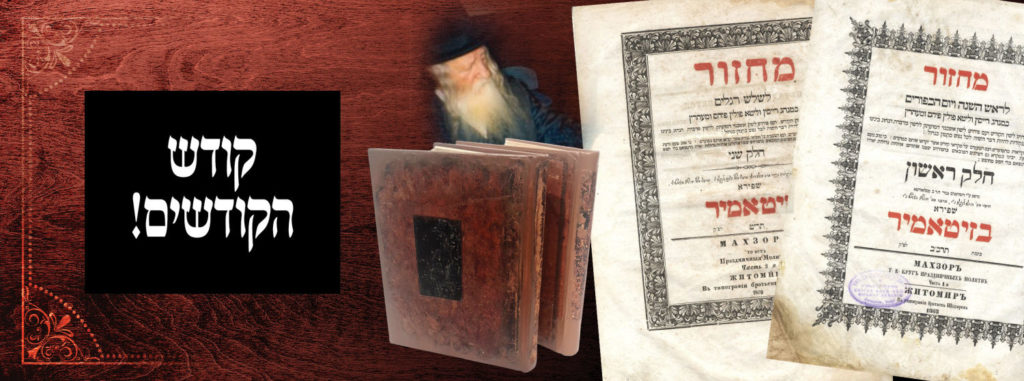
— We will retell the sacredness of this day because it is awesome and terrifying —
Machzor for Rosh HaShanah and Yom Kippur. Personal copy that belonged to the Admo”r Rabbi Yehudah [Yehudah’leh] Horowitz of Dzikov, which the rebbe used over many years, as attested in the included confirmation from his close confidante, Rabbi Simchah Hendler. Magnificent rabbinic volume with the original leather binding. Extraordinarily important and rare Chassidic ritual item.
As stated, this is the personal machzor of the renowned tzaddik and wonder-worker, Rabbi Yehudah’leh of Dzikov, who contemporary rebbes considered a tzaddik of earlier generations. The rebbe shed his soul’s spiritual tears over these machzorim in his renowned glorious prayers to Hashem on the high holidays – awesome wailing. It is worthy of note that its leaves are soaked with the rebbe’s tearstains, especially the leaves with the shofar-blowing, where the tearstains are even greater.
Refer to the Hebrew catalog text for a brief biography of Rabbi Yehudah Horowitz .
It is known that leading Admo”rim are particular to pray from sefarim that had been in the use of tzaddikim, or to wear clothing that was used by a tzaddik as a segulah for their prayers to break through the mekatregim and enact salvation for themselves and for their congregations. It is hard to find a ritual item more suited for the high holidays than this Zhitomir machzor, used for Divine service by Rabbi Yehudaleh of Dzikov, considered most sacred by contemporary Chassidic leaders.
Specifications: Machzor printed in sanctity and purity by Rabbis Chanina Lipa and Yehoshua Heschel Shapira, Zhitomir, 1862. 157 leaves. 29.5 cm.
Fine-very fine condition: Aging stains. Minimal worming perforations. Innumerable stains of sacred tears. Professionally restored original leather bindings.
Confirmation included from the Rebbe’s close confidante, Rabbi Simchah Hendler, regarding the authenticity of this machzor and that the tzaddik used them over many years.
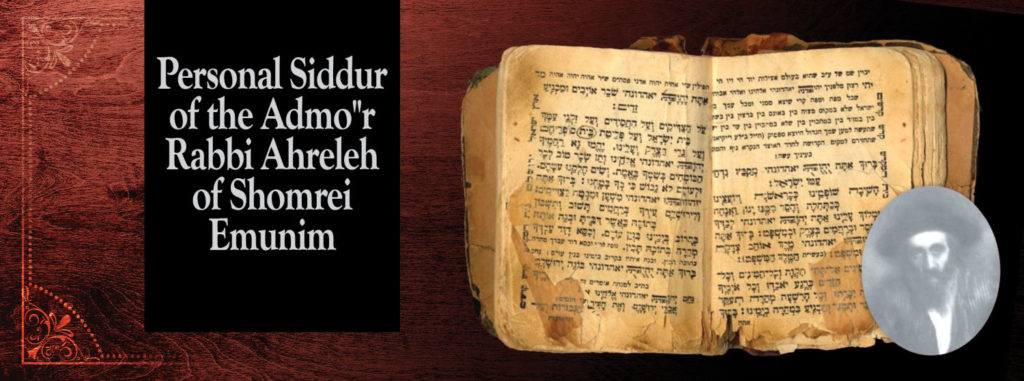
Siddur Taharat HaLev – personal copy of the sacred and lofty Admo”r … Rabbi Aharon Roth, author of Shomrei Emunim . In the siddur before us, the Admo”r poured out his heart and soul before his Creator with his pure prayers, as a son ingratiating himself before his father. Moving ritual item, very exciting.
This siddur belonged to the exalted Chassid, Rabbi Shabtai Shachna Frankel (brother-in-law of the gaon Rabbi Meir Bransdorfer), who testified (per his son’s testimony) that this siddur was used by the Admo”r, the author of Shomrei Emunim for prayer.
It can be seen that the Admo”r used this siddur for a prolonged period, as is evident from the siddur’s worn leaves and the many usage stains. It is exciting to see how (almost) every leaf was personally handled for prayer from the depths of his heart.
Among the leaves of the siddur, there are several handwritten glosses and marks. In the siddur are also partial leaves and beard hairs, which according to the ancient custom, are stored in the pages of the siddur.
The Admo”r Rabbi Aharon Roth [1894-1947] was born in Ungvar and studied at the Weitzen yeshivah. He then drew close to Chassidut and served the Admo”rs of Kosson, Belz and primarily Rabbi Tzvi Elimelech Shapira of Bluzhov, who encouraged him to serve as an Admo”r. He gathered groups in Satmar and then in Beregszász and in the Land of Israel whose focus was a lifestyle based on specific regulations, mainly in the areas of purity and lively prayer. His works include Shomer Emunim , Shulchan HaTahor and Taharat HaKodesh . He established the Shomer Emunim group in Jerusalem, which later on became a Chassidic court.
The Taharat HaLev siddur was printed per the Slavuta edition in Jerusalem, 1927.
Moderate condition. Many usage stains. Wine stains. Many blemishes and lacks. Lacking leaves. (Another copy of this edition is included for any completion needs.)
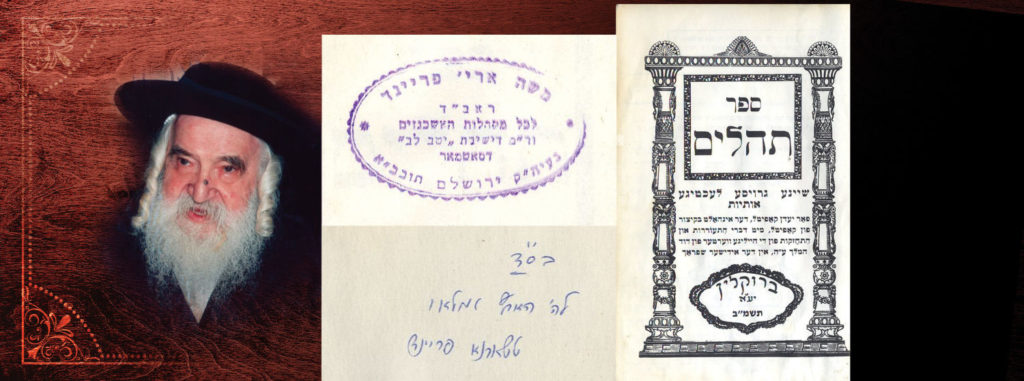
“He stands in one corner, praying, and she stands in another corner, praying”
Book of Tehillim with which the gaon Rabbi Moshe Aryeh Freund, gaon av beit din of HaEdah HaChareidit and one of the leading tzaddikim of recent generations and his wife the Rebbetzin would pour out their heart. Published by Satmar, Brooklyn, [1982].
Appearing at the beginning of the book of Tehillim is the personal stamp of the gaon av beit din : “Moshe Aryeh Freund rosh av beit din of all the Ashkenazic communities and Ra”m of the Satmar Yitav Lev Yeshiva in Jerusalem”. In additןon, appearing on the leaves of the book is the stamp of his pure wife the Rebbetzin: “Tsharne Freund Jerusalem”.
The book of Tehillim is well used, showing the thousands of tear-soaked prayers of the gaon av beit din and the Rebbetzin. As is known, after his offspring had persihed in the Holocaust, the gaon av beit din did not have other children. This is the book of Tehillim into which the gaon av beit din and the Rebbetzin poured their pure heart before Hashem with insufferable pain, a book that absorbed tens of thousands of hours of prayers by one of the leading tzaddikim of recent generations!
At the beginning of the book we find an important, unknown gloss by the gaon av beit din Rabbi Moshe Aryeh Freund. In the version of the “Yehi Ratzon” which is traditionally said before the saying of the Psalms, it says “and do not take us from this world before our time until our days there reach seventy years”; the gaon av beit din surrounded the words “seventy years” with parentheses, indicating they are not to be said.
Refer to Hebrew catalog text for a brief biography of Rabbi Moshe Aryeh Freund .
168 pp, 2 leaves, 23 cm.
Fine condition: many marks of usage. Aging stains. Partly detached binding.